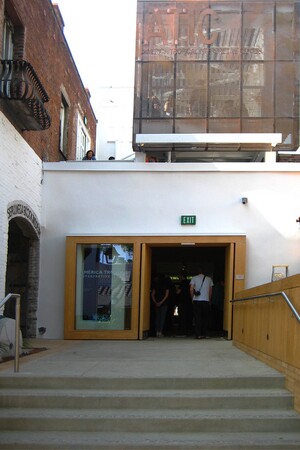Welcome Back, 'América Tropical'

The final message from "América Tropical" isn't about politics or censorship. It's about a city recognizing the vaule of a mural as an artistic resource. After decades of neglect, advocacy, then conservation, it will appear in its recovered state 80 years to the day when it was first seen.
The colors are muted. It's impact isn't. "América Tropical" and its layers has something for everyone.
Los Angeles art and political historians have been fascinated with the story of the exiled Mexican muralist David Alfaro Siqueiros and his commissioned 18-by-80-foot fresco mural on Olvera Street. Welcomed by the art community of the day, he was feted, and taught classes to local artists who so believed in his technique and storytelling.
Siqueiros, always an innovator in technology, may have had more on his mind being so close to Hollywood. He considered how modern apparatuses would allow projected moving images to be part of his future works. It is intriguing to think such a notion was in Siqueiros' mind when he projected photographic images on the wall to use as reference, applying paint by spray gun.
The believers will know of the work and its history that there was a storm of controversy when it was first seen, with its central image of an indigenous figure dangling from a double cross. On top is an American eagle, the artist's symbol of imperialism hovering with its dominate and oppressive wingspan. The image, then the rest of the mural, was painted over soon after.
In the late 1960s, the story of the mural began to reappear in the public eye, prompting art scholars Shifra Goldman and Josefina Quezada to begin a campaign to save the piece; that led to teaming with KCET filmmaker Jésus Salvador Treviño and other advocates to raise interest (Watch this documentary at 10:30 p.m. on Thursday, October 11 on KCET). In 1988, The Getty stepped in, beginning a careful conservation process that was stopped and started due to funding, bureaucracy, and adjusting of the project to shape a final presentation.

Visitors making the pilgrimage to "América Tropical" will enter the América Tropical Interpretive Center from Olvera Street, introduced as "ATIC" over the door, and be introduced to the exhibition with video, audio, and interactive displays (Edward James Olmos is the voice of Siqueiros' writings and thoughts). Located on the first floor of the Sepulveda House (1877), the interpretation is not as much about the work itself, but rather the connection between Siqueiros, the mural, the city, its conservation, and the way muralists have been influenced by the mural's method and message.
The outdoor rooftop platform, reached by stairs or elevator, holds 20 people at a time and is 150 feet away from the work. The mural sits under a steel framed canopy mural held up by two beams that bypass the fragile building and reach down to the ground. One beam is engineered to avoid Zanja Madre, the "mother ditch," that bisects a corner of the building, Italian Hall, that is home to the mural.
According to those who attended a preview for city employees last week, the galleries of interactive stations and photographs have a broad focus in covering Siqueiros' artistic and political reputation, the backstory of Olvera Street, and the advocacy to save the mural when it began appearing from under its cloak of paint.
Olvera Street founder Christine Sterling, who has been documented in countless academic and historical accounts as the person who ordered the whitewashing of the mural, and whose action is still a symbol of artistic censorship, finds her honor as a civic visionary defended. It is suggested that city fathers -- with the goal to romanticize Los Angeles and California and unable to withstand the idea of revolution tainting the serene village of greater Los Angeles -- are the real reason for the eradication of "América Tropical."
That whitewashing of Sterling's notorious reputation may prompt cries from advocates who prefer to see the mural as a political statement, yet if it were not for the loss of "América Tropical," its meaning of what it meant to and still says would likely be gone today.
Starting this morning, Siqueiros has the last word.
Photos I Helen Ly for KCET